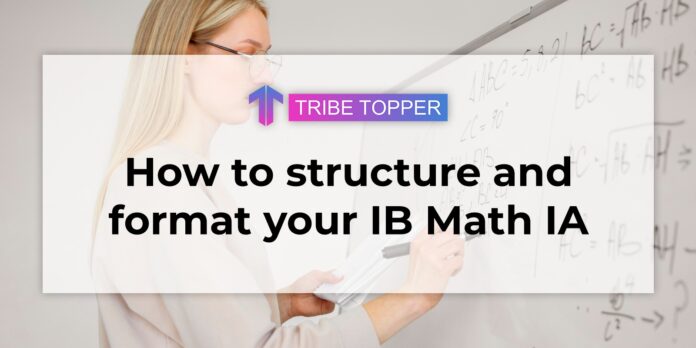Are you preparing to present your mathematical IA? In this article, we’ll go over how to format yours in a way that encourages critical thinking on your own and active participation from the reader. You can succeed in your maths course by following this advice and practicing Math IA Past Paper.
Understanding the Purpose of Math IA
Students must research a mathematics topic and present their findings in a written portfolio.
This makes it obvious that for the learner to participate in the issue, they must be familiar with the necessary mathematical terminology. While there are other ways to format your math IA, we advise following the guidelines below.
Each student will be able to present their findings consistently and effectively by adhering to this tried-and-true structure for your math IA.
IA standard that pupils must adhere to :
Engagement and personal connection to the topic are essential. Learn the procedures listed below before diving into your topic of choice. Technology can be used to undertake a thorough investigation of the subject.
There are several circumstances in which mathematics can prove and explain notions. The exam is a fantastic opportunity for students to increase their knowledge and acquire useful skills.
The concept and goal of the job must be clearly stated in your assessment. This will aid in maintaining the focus of your data analysis. You must communicate these concepts in your writing. This is a branch of mathematics that is loosely related to numbers.
The quality of the concept and the body of work will be evaluated in light of the evaluation criteria by the examiner.
How to Format and Structure Math IA
According to student reviews, IB Maths is a challenge for many students pursuing diplomas. You must submit an analysis of a topic in addition to the dreaded arithmetic exam.
The IA can be compared to a written presentation of mathematics that will affect your final mark.
Mathematical ideas might be challenging to study for many IB students. You may learn new, pertinent logic through this approach that you were not aware of before.
Where do you even start your IA, then? IA format should be used first!
What is the internal assessment in the math IA structure?
The internal assessment is a personal evaluation that concentrates on work linked to the subject.
For the final mark, the IB also receives samples of the student’s work and the requirements (oral presentations, portfolios, lab reports, and essays).
It should demonstrate a commitment to the subject at hand. In this instance, the focus is on the analysis and association of mathematical ideas.
Examining the Math IA Assessment in Detail Mathematical Language That Is Appropriate
Let’s examine the requirements for your Math IA.
- Presentation (4 points)
The presentation is the subject of the first criterion, which evaluates your IA’s overall coherence and arrangement.
Students frequently concentrate on the intricacy of arithmetic that their investigation reveals, but your explanations and structure are given 4 points for clarity. Make sure your IA is organized if you want to receive a high score in this area. In the part after this one, we’ve provided the ideal format.
- Communication in Mathematics (4 points)
The second criterion is mostly concerned with the mathematical terminology you have employed, such as:
- symbol
- notations
- Term usage
Assure the accuracy and consistency of these three elements throughout your IA. It would be better to use mathematically complicated words like “substitute” instead of phrases like “plugin” or “put in.
- Personal engagement (3 points)
Your involvement must be genuine and contribute to the exploration to receive the highest ratings for personal participation.
It must be independent and distinctive. It shows inventiveness in conveying mathematical concepts and looking at the subject from numerous angles.
This entails generating assumptions about potential areas of interest and then figuring out how to modify the issue, formula, or question to cover those topics.
- Reflection (3 points)
The IB requires more of us than just showing off our accomplishments.
Connect the outcomes to the original objectives during the reflective phase. You can come to conclusions along the way by doing this.
It involves analyzing the research to find evidence above what would be found in a conventional mathematical test.
Learning is the focus of the IB; therefore, demonstrate to the marker how you improved throughout the IA.
- Utilization of math (6 points)
This part examines the calibre of the arithmetic and its applicability to the investigation.
The IB can determine how relevant your inclusion was by ensuring that you only provided arithmetic specifically designed to address the study topic.
It Is also important to note that the mathematics created should be on par with the level of mathematics covered in your course curriculum. This doesn’t imply you can only research the subjects listed on your syllabus, but it should still be done with the same rigour!
Format of IB math IA:
- Intro:
Your math internal exam must start with a crystal-clear introduction that establishes the context and goal of the entire exploration, just like practically all of your other internal assessments.
It is a fantastic opportunity to demonstrate your ‘personal engagement’ with your selected IA topic. Include your interest in the topic, how it relates to your life, your prior understanding of it, your goals, and the process you’ll use to conclude.
You may also include any unique problem statements and describe your thorough analysis approach.
Body:
Your IA exploration should focus on the subject you have selected to research and the pertinent mathematical information that will answer the work’s stated goal.
The degree and clarity of your mathematics are crucial factors to consider. The IB awards significant marks for the usage and communication of mathematics, so keep this in mind when you write your Math IA!
- IA investigation:
As with all evaluations, the math IA inquiry must include a strong conclusion summarising your effort and research.
What conclusions did you draw, and was your objective explored at the outset of the Math IA?
Importantly, talk about some of the difficulties you had when writing your IA and what you might have explored if you had had additional time and space.
Finally, take a step back and consider the wider ramifications of your research.
How has learning changed your life, or how might it change others’ lives? How has your involvement helped you to consider various mathematics-related issues?
- Length:
Your Math IA Mock Paper has no set word limit, but the IB suggests that the exploration be between 12 and 20 pages long.
- The Right Fonts and Spacing for Math IA:
While there are no set standards for the type of font you should use, generally speaking, double line spacing with 12 font sizes and Arial or Times New Roman are the best options.
Your work can be presented either handwritten or in a word processing program (such as Microsoft Word or Pages).
- Diagrams and graphs:
You want to incorporate pertinent diagrams, charts, and tables.
Don’t just include these as appendices at the end of the essay; make sure they are completely and clearly labeled so the examiner understands what you’ve included and why.
It Is a crucial component of your study and demonstrates your understanding of the examples you used in your analysis.
- Bibliography and Citations:
You should include a complete bibliography listing all your sources at the end of your report. You must cite all direct quotes you utilize in your essay and include a bibliography at the end.
Conclusion
This focuses on a methodical examination of the concept and IB design. Tribe Topper offers the greatest IA Math Mock Question Bank for all IB, IGSCE, and IB DP subjects. Thus, for a score of 7, consult Tribe Topper regardless of the topic you are studying.








